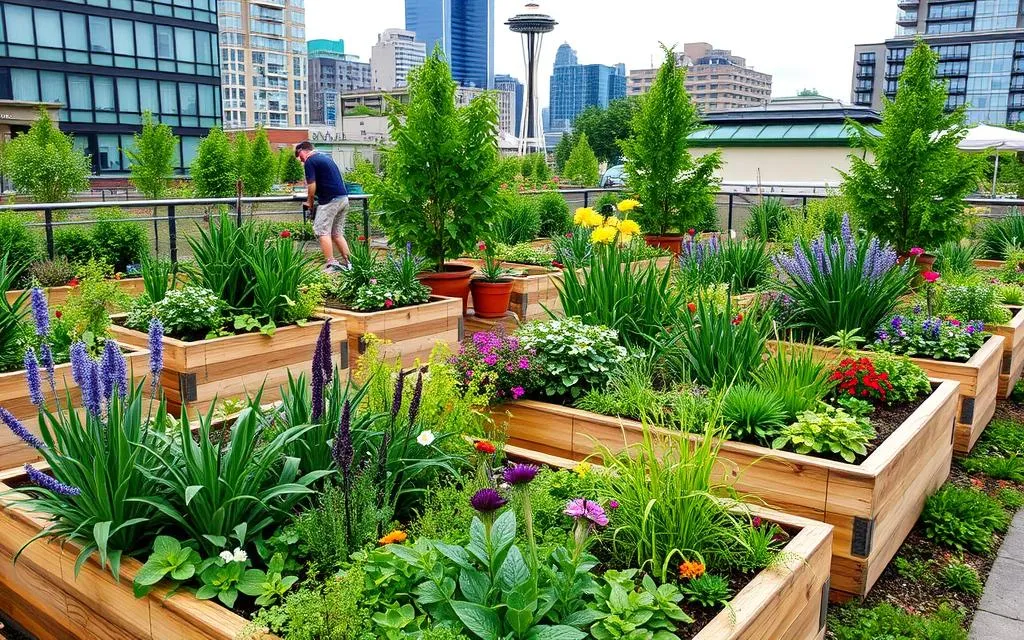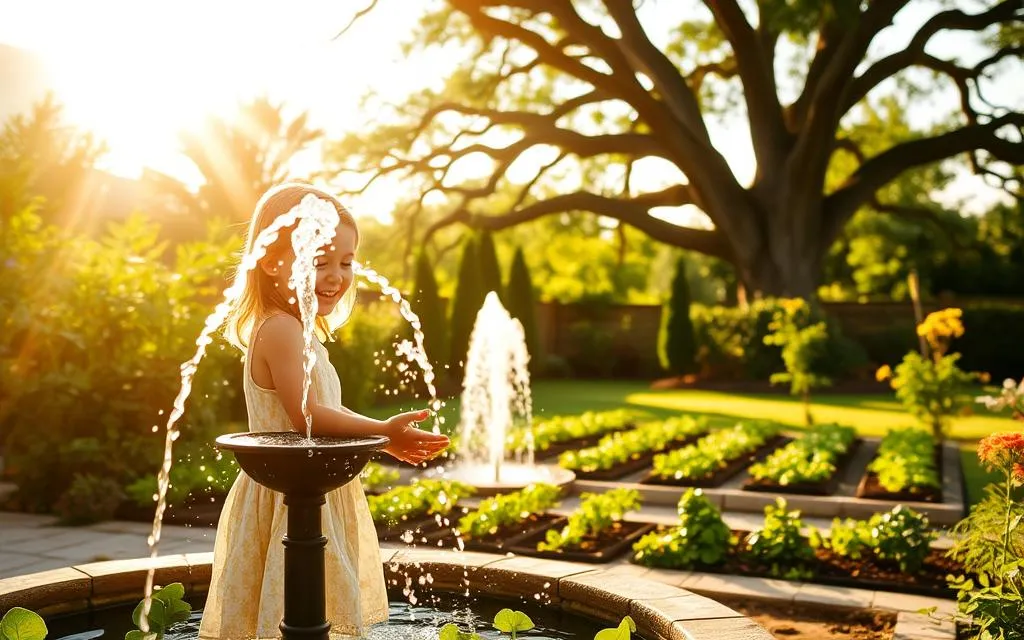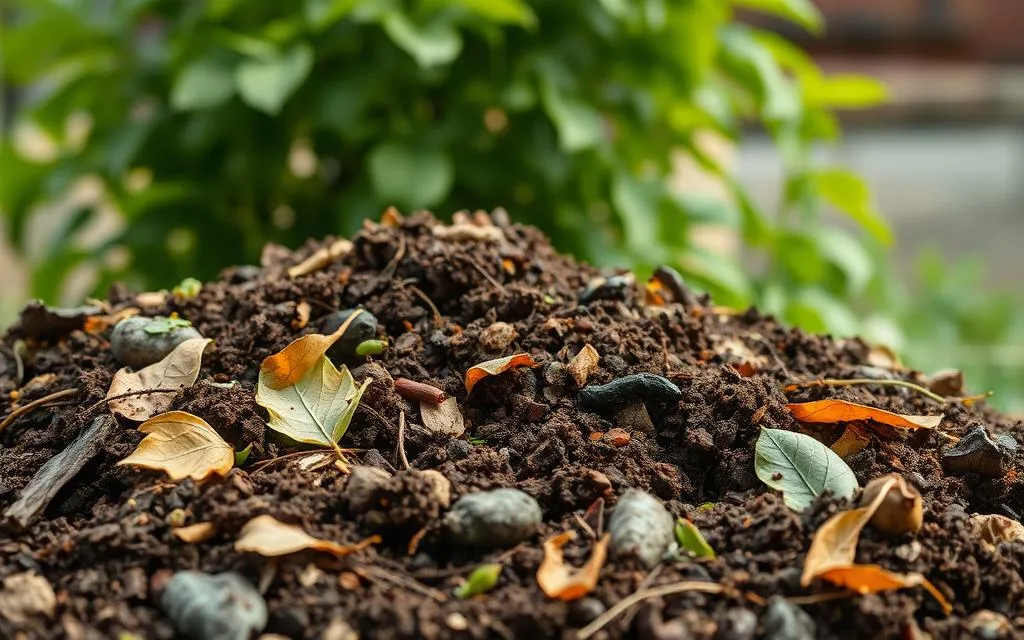Seattle is a city in the Pacific Northwest that’s full of life and gardening opportunities. It’s perfect for those who want to grow their own food, create a beautiful garden, or just enjoy nature. This guide will show you how to get a garden bed in Seattle. We’ll cover the benefits, challenges, design, building, and upkeep of your garden.
Gardening in Seattle has its ups and downs. You’ll face rainy seasons, pests, and diseases. But with the right approach, you can overcome these challenges. You can make a garden bed that gives you fresh produce, beautiful flowers, and a quiet place to relax.
We’ll talk about the important parts of getting a garden bed in Seattle. We’ll cover site selection, building the bed, planting, and maintenance. Our step-by-step guide and expert advice are here to help. They’re designed for both experienced gardeners and beginners. Together, we’ll make sure your garden bed is perfect for Seattle’s climate.
Table of Contents
ToggleUnderstanding the Importance of Garden Beds in Seattle
Living in Seattle, we face unique gardening challenges. Heavy rain, cool temps, and short seasons make it tough to garden. Yet, having a garden bed is crucial. It boosts food production, soil quality, and mental health.
Benefits of Having a Garden Bed
Garden beds let you grow more plants and produce more food. They protect plants from harsh weather and help soil conditions for better growth. This means more fresh, healthy food for Seattle’s food lovers.
They also make the soil better, which is often poor in urban areas. By adding organic matter, gardeners create a rich soil environment. This supports plant health and helps the local ecosystem.
Gardening is good for your mind too. It reduces stress and boosts well-being. Tending to a garden bed is calming and rewarding, offering a break from city life.
Challenges of Gardening in Seattle’s Climate
Gardening in Seattle has its challenges. The cool, wet climate and short season make it hard to grow some plants. Pests and diseases, like slugs and mildew, are also common issues.
But, with the right techniques, like raised beds and cold-weather crops, gardeners can succeed. They can create gardens that support Seattle’s food culture and green spaces.
Choosing the Right Location for Your Garden Bed
Choosing the right spot for your garden bed in Seattle is key to a thriving garden. Look for places with plenty of sunlight, good drainage, and easy access. Let’s dive into what makes a spot perfect for your garden bed in Seattle.
Sunlight Exposure
Sunlight is crucial for your garden’s health. Most plants love full sun, needing at least 6 hours of direct sunlight daily. Check the area at different times to make sure it gets enough sun.
Drainage and Soil Quality
Good drainage is vital to avoid waterlogged soil. This can cause root rot and harm your plants. Look for areas with well-draining soil and avoid places with standing water or heavy runoff.
If your soil is heavy clay or compacted, you might need to add materials to improve drainage.
Accessibility and Convenience
Think about how easy it is to reach your garden bed for upkeep. Pick a spot that’s easy to get to for watering, weeding, and picking. Being close to water or your home can make gardening easier.
By picking the right spot for your garden bed in Seattle, you’ll help your garden flourish. This way, you’ll get a great harvest from your urban garden.
| Factors to Consider | Ideal Conditions |
|---|---|
| Sunlight Exposure | At least 6 hours of direct sunlight per day |
| Drainage and Soil Quality | Well-draining soil, not prone to waterlogging |
| Accessibility and Convenience | Close to a water source and your home |
Preparing the Ground for Your Garden Bed
Turning your Seattle backyard into a garden oasis starts with the right ground prep. This step is key for your plants to grow well. It’s the first step to a great harvest. Let’s look at how to test the soil, fix it, and clear out old plants to prepare your garden bed.
Soil Testing and Amending
Soil in Seattle changes a lot, so testing yours is a must before planting. This tells you what nutrients your soil lacks or has too much of. A soil test shows the pH level, how much organic matter it has, and if it has enough nitrogen, phosphorus, and potassium.
After testing, you can fix the soil. You might add compost, lime, or other stuff to make it better. Good soil means your plants will grow strong and healthy.
Removing Existing Vegetation
Before making your new garden bed, you must clear out any old plants. This is key to stop them from fighting with your new plants for food and water. You can pull them by hand, till the soil, or use a special weed killer to get rid of them.
Preparing the ground well sets your garden up for success. With tested and fixed soil and no weeds, your plants will start off strong in your Seattle garden bed.
Designing and Building Your Garden Bed
Starting your Seattle garden means deciding between raised or in-ground beds. Each has its own benefits, based on soil quality, ease of access, and what you like. The choice is yours.
Raised Bed vs. In-Ground Bed
Raised beds are popular in Seattle for its heavy clay soils. They lift the soil, creating a spot that drains well and is full of nutrients. This is perfect for many plants. Plus, they’re easier to get to, which is great for those who have trouble moving around.
In-ground beds work well if your soil is already good quality. They blend into your yard easily and can save money. But, they might get compacted and have more weeds.
Materials and Tools Needed
Building your garden bed, whether raised or in-ground, requires some key items. For raised beds, you’ll need lumber like cedar or redwood, a strong frame, and fabric to keep weeds out. In-ground beds just need basic tools like a shovel, rake, and tiller to get the soil ready.
| Materials for Raised Beds | Tools for In-Ground Beds |
|---|---|
|
|
Think about your options and get the right materials and tools. You’ll be ready to create a garden bed in Seattle that fits your needs and tastes.

how to get a garden bed in seaattle
Getting a garden bed in Seattle is rewarding and empowering. It lets you grow your own food and make a green space in the city. Whether you’re experienced or new to gardening, there are steps to make your dream a reality.
Start by looking into community gardening programs in your area. These programs offer plots for residents to garden. But, they often have long waitlists, so apply early to get a spot. The city of Seattle might also have land for rent for personal garden beds.
After finding a spot, make sure you have the right permits and approvals. You might need a permit or license, depending on the land and zoning rules. The city’s website or local gardening groups can help with this.
Think about soil quality, sunlight, and how easy it is to get to your garden bed. Raised beds are great in Seattle because they help with poor soil or limited space. You’ll also need tools and materials like lumber, soil additives, and gardening tools.
With careful planning and preparation, you can get a garden bed in Seattle. Start growing your own fresh, healthy food. Follow these steps and use local resources to create your urban oasis.
Planting and Maintaining Your Garden Bed
After setting up your garden bed, it’s time to start planting. Picking the right plants for Seattle’s climate is key to a successful garden. Also, knowing how to water and fertilize your plants is crucial for their growth.
Choosing the Right Plants
For Seattle’s cool, wet climate, choose plants that can handle it well. Great options include:
- Rhododendrons and azaleas, which love the acidic soil
- Hostas, for their vibrant foliage in shady spots
- Salal and Oregon grape, native plants that are tough and easy to care for
Make sure to check the specific needs of each plant to see if they fit your garden bed’s conditions.
Watering and Fertilizing Tips
Watering and fertilizing right are important for a healthy garden in Seattle. Because of the wet climate, watch out for overwatering. Stick to a regular watering plan and check the soil often. For fertilizing, use a slow-release fertilizer to feed your plants steadily throughout the season.
| Watering Recommendations | Fertilizing Recommendations |
|---|---|
|
|
By picking the right plants and caring for your garden well, you’ll have a thriving garden in Seattle.
Dealing with Pests and Diseases
No garden is safe from pests and diseases, especially in Seattle’s unique climate. As gardeners in the Pacific Northwest, we know how tough it can be to keep pests away. We’ll talk about common problems like slugs, aphids, and powdery mildew. We’ll also share eco-friendly ways to keep your plants safe.
Common Pests in Seattle Gardens
Seattle’s cool, damp weather is perfect for pests that can harm your garden. Some pests you might see include:
- Slugs and snails: These pests can eat young plants and damage leaves.
- Aphids: These tiny insects suck plant sap, slowing down plant growth.
- Cutworms: These caterpillars live in the soil and can cut through plant stems.
- Spider mites: These tiny pests eat the underside of leaves, causing them to wilt.
To fight these pests, try organic and natural methods. Use hand-picking, barriers, and beneficial insects like ladybugs and lacewings.
Common Diseases in Seattle Gardens
Seattle’s climate also brings diseases to plants. Some common diseases are:
- Powdery mildew: This disease makes leaves look white and can slow plant growth.
- Botrytis blight: Also called gray mold, it grows in damp places and can rot flowers and leaves.
- Downy mildew: This disease turns plants yellow, wilts them, and can kill them.
To fight these diseases, keep air moving, don’t overcrowd plants, and choose resistant varieties. Use organic fungicides or natural remedies like baking soda solutions too.
Knowing about pests and diseases in Seattle gardens and using eco-friendly ways to manage them can help you have a great garden season.
Extending the Growing Season
In Seattle, we face the challenge of a short growing season. But, with the right methods, we can make our garden beds more productive. This means we can enjoy a harvest all year. We’ll look at strategies for cold weather gardening and protecting our garden beds in winter.
Cold Weather Gardening Techniques
To make our growing season longer in Seattle, try these cold weather gardening tips:
- Use cold frames or cloches to create a microclimate and shield your plants from frost.
- Experiment with row covers or low tunnels to trap heat and provide an extra layer of insulation.
- Grow hardy, cool-season crops like kale, spinach, and broccoli, which can withstand the colder temperatures.
- Utilize mulch to retain soil moisture and prevent soil from freezing, protecting the roots of your plants.
Protecting Your Garden Bed in Winter
Keeping your garden bed safe during Seattle’s harsh winters is key. It helps your plants survive and prepares for next year’s growing season. Here are some tips to protect your garden bed:
- Add a thick layer of organic mulch, such as straw or leaves, to insulate the soil and prevent it from freezing.
- Consider building a simple hoop house or cold frame to shield your plants from the elements.
- Plant cover crops like winter rye or crimson clover to enrich the soil and prevent erosion during the off-season.
- Wrap or insulate any exposed water pipes to prevent them from freezing and bursting.
By using these methods, you can extend the growing season in your Seattle garden beds. You’ll have a thriving, productive garden all year. With a bit of effort, you can beat the challenges of cold weather gardening in Seattle. And you’ll make sure your garden beds are protected during winter.
Conclusion
Creating a garden bed in Seattle is rewarding and fulfilling. It’s about understanding the importance of garden beds and how to make your urban oasis thrive. By doing so, you can enjoy the many benefits of urban gardening in the Emerald City.
Key takeaways for a successful garden bed in Seattle include picking a sunny spot with good drainage. Adding organic matter to the soil helps too. Also, think about the unique climate challenges to help your plants grow well. With proper planning and care, your garden bed can be a source of fresh produce and beauty.
Our final thoughts on gardening in Seattle suggest joining the city’s vibrant gardening community. Look into local resources and workshops. Try out cold-weather gardening to grow more throughout the year. Starting a garden bed in Seattle takes patience and effort, but the rewards are huge. Enjoy the fresh produce and the joy of caring for your own garden.
FAQ
What are the benefits of having a garden bed in Seattle?
A garden bed in Seattle boosts food production and soil quality. It also improves mental health through gardening. These beds help with Seattle’s climate challenges like heavy rain, cool temps, and short seasons.
What are the best locations for a garden bed in Seattle?
Pick a spot for your garden bed in Seattle with good sunlight, drainage, and easy access. We’ll help you check your space to find the best spot for your garden.
How do I prepare the ground for my garden bed?
First, prepare the ground for your garden bed. Test and amend the soil for nutrients. Remove any plants to clear the area for your garden.
Should I choose a raised bed or an in-ground bed for my Seattle garden?
We’ll help you choose between a raised or in-ground bed for your Seattle garden. Consider soil quality, access, and upkeep. We’ll list the materials and tools you need for your garden bed.
What are the steps to get a garden bed in Seattle?
We’ll guide you to get a garden bed in Seattle. Options include community programs, city land, or your property. We’ll cover permits, costs, and requirements for your urban garden.
What are the best plants to grow in a Seattle garden bed?
We’ll help you pick plants for your Seattle garden bed that fit the local climate. Learn about watering and fertilizing to keep your garden healthy.
How do I deal with pests and diseases in my Seattle garden bed?
Seattle gardens face pests and diseases. We’ll discuss common issues like slugs and aphids. Find eco-friendly ways to protect your garden bed.
How can I extend the growing season for my Seattle garden bed?
Seattle’s short season doesn’t mean a small harvest. Learn to extend your season with cold frames and row covers. Protect your garden bed in winter to keep plants thriving all year.






